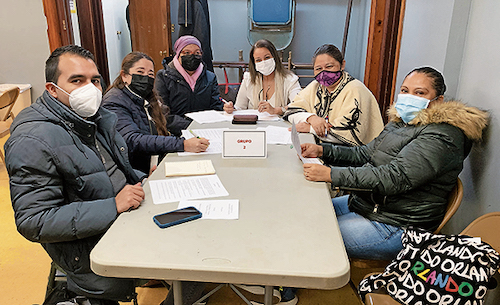
PROSPECT HEIGHTS — A moment that stands out to Father Joseph Gibino from the Diocese of Brooklyn Synod on Synodality listening sessions came Jan. 6, when Msgr. David Cassato reminded priests of the need to embed themselves — become “street priests” — in their parish communities.
“Msgr. David Cassato said that we need to be priests who know our parishioners because the parishioners have said that over and over again,” said Father Gibino. “They want to be known by their clergy. They want to see their clergy on street corners and in churches.”
The message from Msgr. Cassato is one of many pieces of feedback the diocese has received from parishioners so far, as it’s about halfway through the slate of synod listening sessions between Bishop Robert Brennan, clergy, and parishioners.
Father Gibino, the diocesan vicar for evangelization and catechesis, heads the diocese’s synod efforts with Sister Maryann Seton Lopiccolo. He said that there have been three recurring responses from parishioners to date: The need for outreach and faith formation for youth and young adults, the need for outreach to families, and the need to look at the diverse populations of the diocese with a particular focus on leadership in the Hispanic community.
“Being at so many of these listening sessions has really given me an insight into the direction where our secretariat needs to head,” Father Gibino said. “The two areas where I see our office being really challenged to action will be in those two areas, and then ramping up our total faith formation program for leadership in Spanish.”
Father Gibino noted that to reach young adults parishes need to include them in leadership and decision-making roles, and his office needs to encourage “strong, vibrant youth and young adult ministry” at every parish.
When it comes to family ministry, Father Gibino said it’s important to bolster programs that already exist. He also envisions bringing together the diverse populations of the diocese with the help of the Holy Spirit Institute for Service and Leadership.
“It is really a challenge if you have a parish community that say, has three dominant language groups. We don’t want to ever sense three parishes,” Father Gibino said. “We want one parish that is inclusive of everyone, and so the more leadership that we have trained to be able to bring that vision of unity into reality is what’s going to be important.”
To date, 13 of a likely 26 listening sessions have been completed — one for each of the diocese’s 22 deaneries and four with specific communities. Eleven of the 13 completed sessions were deanery sessions. The two special sessions were with youth and young adults and the Vicariate for Hispanic Concerns, led by Auxiliary Bishop Octavio Cisneros, Father Gibino said.
The remaining sessions are with the other 11 deaneries, the Polish community, and members of Bishop Brennan’s staff. Father Gibino said the last session is scheduled for March 9.
Each session lasts from 5-9 p.m. Customarily, at 5 p.m. Bishop Brennan meets and has dinner with the priests of the deanery. Then at 7 p.m., he celebrates Mass for the parishioners of the deanery. From 8-9 p.m. the formal listening session takes place.
The feedback from each session is compiled in a comprehensive report that Father Gibino and the synod team will prepare to have ready for Bishop Brennan in May. The report will then be submitted to the United States Conference of Catholic Bishops in June. The diocesan phase of synod wraps up in mid-August.
“Once we have that final document finished, that really will be a roadmap for where we should be going,” Father Gibino said. “We will be ready to hit the ground running.”
Two other pieces of listening session feedback that caught Father Gibino’s attention were the transient nature of the diocesan population and the aging of the diocese. He said that in certain parts of the diocese there’s a large young adult population that seems to be moving away. Meanwhile, other communities seem to be aging and moving closer to family.
“That seems to be true in our diocese that people stay for a while and then move on, so it’s hard to establish that grassroots, really stable community,” Father Gibino said.
With a few months left in the process, there will soon be another way for diocesan parishioners to provide feedback for the synod. Father Gibino said a QR code will soon be available in The Tablet that anyone can download and send responses directly to the synod committee.
“What we’re hoping for is to get those Catholics who may feel disconnected to a parish, or who may feel unwanted, to get this out to them so they will have a voice in this process also,” Father Gibino said.
FINDINGS SO FAR
To date, three needs in the diocese have been consistently voiced by parishioners who have participated:
- Outreach and faith formation for young people
- Outreach to families
- Focus on diverse populations, in particular Hispanic community leadership

